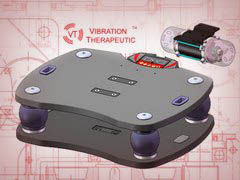



Linear vibration and pivotal oscillation are the most widely used vibration movement patterns for whole body vibration machines in the market, although different manufacturers may use different terms to refer to these two type of movement patterns. These two types of vibration machines have different performance and effect on human body. Below we take a close look of the comparisons.
The animations below show the movement patterns of each type of vibration plate machine.
| Linear Vibration Eccentric Wheel & Spring System |
Pivotal Oscillation Planar Four-Bar Linkage System |
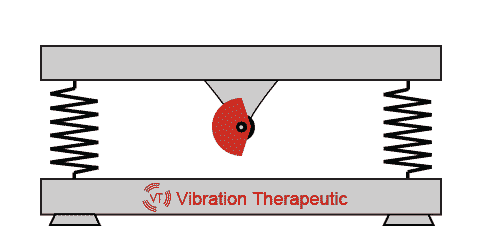 High Frequency, e.g. 15-50Hz Low Amplitude, e.g. 1-3mm |
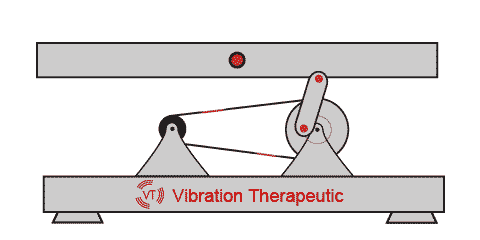
Low Frequency, e.g. 5 - 15Hz High Amplitude, e.g. 13mm at the edge. |
| VT003F Solidworks Drawing | VT020 Solidworks Drawing |
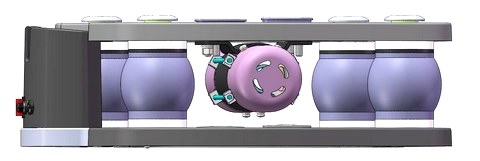 |
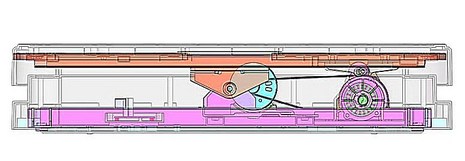 |
A linear vibration plate is a spring and eccentric wheels system. The rotation of eccentric wheel generates circular centrifugal force that drives the upper plate move in a circular pattern. The supporting springs regulate the upper plate to move mostly in vertical direction and less in horizontal direction. The word "linear" comes from the linear attribute of spring, which means force and displacement are in proportion (linear relationship).
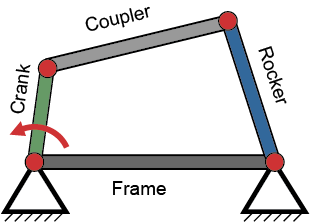
A pivotal oscillation plate is essentially a planar four-bar linkage system driven by a motor through a belt. The belt transfers the motor power to rotate the crank wheel. The crank wheel is linked to the upper plate (the rocker) by the coupler bar. As the crank wheel rotates, the coupler bar drags the link point up and down. The upper plate moves exactly like a seesaw swinging on a fixed pivotal axis. The movement is literally called pivotal oscillation.

Planar four-bar linkage system can be used to create horizontal direction movement as well. A dual motor vibration plate consists of two sets of planar four-bar linkage systems, one creates vertical pivotal oscillation, the other creates horizontal slide type of movement. The Solidworks engineering picture on the right shows the structure of a dual motor vibration plate developed and manufactured by Zhejiang Jintuo.
Almost all whole body vibration plates in the market use either eccentric wheel system or planar four-bar linkage system. Some sellers may use, or misuse, different terminologies to refer to these two types of vibration plates.
Besides different movement patterns, the two types of vibration have some other major differences that affect each of their applications for whole body vibration.
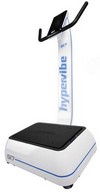
Linear vibration plates can be made to operate at very high frequency. However, for whole body vibration, frequency above 50Hz may be considered hazardous. Most linear vibration plates in the market are designed to work in the frequency range between 15Hz to 50Hz, as represented by Power Plate series vibration plates.
Pivotal oscillation plates in the market are mostly designed to work in the frequency range below 15Hz. It is not practical to make pivotal oscillation type of vibration plate to run on very high frequency, because of the material and components constraints. On the market, the highest vibration frequency available for pivotal oscillation type of vibration plates is 35Hz. such as some Galileo and Hypervibe (G17) models.

Linear vibration plates are all designed to work with low amplitude. The reason is that the supporting springs need keep certain rigidity to support and stabilize the body weight. The needed rigidity constrained the elastic limit. Most linear vibration plates have max amplitude of 3mm. The upper platform of linear vibration plate moves in parallel pattern, the amplitude is the same across the entire platform. Linear vibration plate can be designed to allow user to choose amplitude settings, through engaging different number of eccentric wheels.
Pivotal oscillation plates, with its four-bar linkage structure, can be designed to work with much higher amplitude. Because the upper platform of pivotal oscillation plate moves like a seesaw, the amplitude is zero in the center and the highest at the two sides. The amplitude referred for pivotal oscillation plate is the amplitude at the two sides of the upper plate. User can NOT choose different amplitude settings. Standing of a pivotal oscillation plate, user can adjust the distance of the two feet to obtain different vertical displacement. Most pivotal oscillation plates on the market have the highest amplitude between 10mm to 13mm.
Whole body vibration plates on the market are either high frequency and low amplitude (linear), or low frequency and high amplitude (pivotal oscillation). High frequency and high amplitude vibration plate may pose safety and hazard concerns.
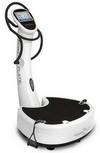
Linear vibration plate's mechanics is a flexible link type, because the spring is a flexible link. Because of the flexible link, the vibration amplitude can yield to body weight. Theoretically the motor power consumption is constant, irrelevant to the body weight. In choosing the suitable rated power for the motor, there is no need to consider power tolerance. Therefore linear vibration plate requires smaller motor. For example, Vibration Therapeutic's VT003F vibration plate, a linear type machine, its 80W motor is more than enough to generate powerful vibration for that structure. Even for very powerful vibration plate like Power Plate Pro7, which is probably the largest and the most powerful vibration plate in the market, the designed motor rated power is only 250W.
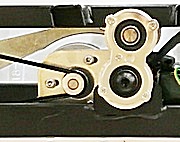
Pivotal oscillation plate's mechanics is a rigid link type, because the planar four-bar linkage system entirely consists of rigid links. The oscillation amplitude is fixed, not affected by the body weight. The body weight decides the motor power consumption. Extra motor power capacity needs to be considered for the situation of sudden load increase, such as when the body weight falls on just one side of the platform. Manufacturers have considered such situation. A practical solution is to make motor to rotate faster to compensate needed motor power at a sudden load surge, especially when the machine is running on a lower frequency setting. For a pivotal oscillation plate that runs max 15Hz frequency and 10 mm amplitude, and designed for body weight below 265lb, a 200W motor is sufficient for a body weight below 265lb.
The belt of pivotal oscillation is a flexible link. It provides a layer of protection to the motor for over load. In normal use, the belt holds well. Over time the belt can become loss.
Linear vibration and pivotal oscillation have quite different effects on the human body, mainly because of the differences on frequency and amplitude.
| Linear Vibration |
Pivotal Oscillation |
|
High frequency, usually between 15Hz and 50Hz Some model has fixed frequency of 30Hz or 35Hz Low amplitude, usually 1 - 3 mm Some linear vibration plates, like VT003F, are designed to have two amplitude settings, high and low. |
Low frequency, usually 5Hz - 15Hz High amplitude, usually 8mm - 13mm Pivotal Oscillation plates do not have amplitude setting. User adjusts the amplitude by adjusting the distance between the two feet while standing on the platform. |
|
Because the vertical displacement is uniform on the platform, users can effectively excercise many poses and postions. |
Because the displacement at the center of the platform is 0, and maximum at the two sides, effective vibration requires two feet (or hands) each on a side of the platform. Sitting and lying poses do not work well. |
|
Linear vibration machine is noisy on high frequency. Vibration also generates sound wave. When the frequency is above 20Hz, the sound wave becomes audible. |
Pivotal oscillation machines, because of low vibration frequency, do not produce a lot of noise. |
On standing pose, the vertical vibration is transmitted to the upper-body and the head through spinal column. Vibration on the stomach and head can cause nausea and dizziness. Using half-squat pose can effectively help reduce and control the amount of vibration transmitted to the upper-body and the head, if vibration on upper-body and head is not desired. |
On standing pose, the seesaw type of of vibration mostly works the leg and hip. The vibration is NOT much transmitted to the upper-body and head. Although the oscillation swing the body in big movement, it usually does not make the user feel uncomfortable. |
High frequency vibration machine transmit energy deep into tissue. |
Low frequency oscillation machine swing the muscle groups in whole pieces. |
High frequency vibration is more effective on therapeutic functions. The benefits include the circulation improvement, tissue repair and regeneration, and pain relief |
Low frequency oscillation is more effective on muscle relax, muscle activation, and balance improvement. |
Compared with pivotal oscillation machine, linear vibration machines more likely cause discomfort due to its high vibration intensity. Also the vibration transmitted to the upper body and head may cause dizziness and nausea.. |
Pivotal oscillation machine enjoys much better user experience, because it's moderate intensity and low impact, and the fact the vibration does not transmit to the upper body. |
Discussions are welcome. Please email to info@VibrationTherapeutic.com.